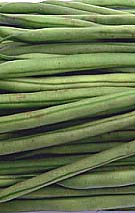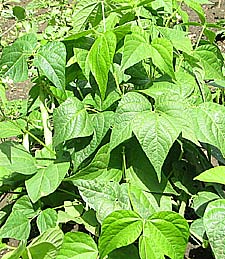French Beans, Dwarf Beans, Haricot Beans
VEGETABLE PAGES
FRENCH BEAN — VARIETIES TO GROW
Tender Green
Sprite
Glamis
The Prince
Phenix Claudia
Canadian Wonder
Earligreen
Masterpiece
Mont d`Or
Granda
Purple Queen
White Lady
CLIMBING VARIETIES OF FRENCH BEAN
Earliest of All
Coco-Bicolor
Blue Lake
Golden Gate

PROBLEMS WITH FRENCH BEANS
Foot Rot - This is a fungus that causes plants to rot
at the base of the stem. To avoid this rotate the crops. Water with Chestnut
Compound.
Anthracnose - Carried by infected seed causes black or
brown spots on leaves and pods. Spray with captan or zineb before flowering
on young plants. The rust shows on the underside of leaves as brown powdery
pustules; after cropping burn the haulms (dry stems and stalks). Use a
fresh site for the next crop.
GARDEN TIP
Chickens love to eat slugs and snails and will appreciate any that you can catch for them.
A good way to catch slugs and snails is to cut large oranges and grapefruit in half and hollow them out.Leave them around the borders in the evening.
During the night the smell of the fruit will attract the slimy pests inside and you can collect them in the morning for your chickens breakfast.
SOCIETIES
FRENCH BEANS

French beans are sometimes called dwarf beans, and many
people prefer them to the coarser runner beans.
They are easy to grow and do not need staking.
There are also climbing and green, golden red and prurple varieties of French Bean
French beans can withstand dry conditions perhaps better than any other crop, and they leave the soil in very good if not better condition after cropping because of the nitrogen built up on the roots.
French beans are picked when they are young and green and you eat the whole pod.
If the pods are left to ripen fully and the beans are dried and stored, they are known as haricot or kidney beans.
PREPARING THE SOIL FOR SOWING FRENCH BEANS
French beans prefer light soil, but can be grown in heavy clay soil if enough fine organic matter is forked in.
During the Autumn or Winter dig in old compost or well rotted manure at one bucketful to the square meter.
Leave the ground rough during the Winter to let the cold winds and frosts get to it.
In the spring give the soil a light forking and add some organic fertilizer.
SOWING FRENCH BEANS
French Bean seed should never be sown if the soil is wet and cold - never pour water in the drill at sowing time.
For an early crop of French beans – sow under cloches.
Start in late March or early April for a harvest in June by sowing seeds in boxes of potting compost in a cold frame 5cm (2in) apart and 5cm deep.
Gradually introduce the seedlings to colder climates by raising the frame light to allow air circulation and leave of completely on fine warm days.
Transplant the French bean seedlings towards the end of May, 22.5cm (9in) between plants and rows 45.5cm (18in) apart.
MAIN CROP FRENCH BEANS
Put cloches in place two weeks before sowing to warm up the ground.
About the last week in April put out a line of string as a guide and form a V-shaped drill 5cm (2in) deep with the hoe.
Sow the French beans seed 15cm (6in) apart and then rake the soil back over lightly to cover the beans completely.
Firm the soil down with the flat part of the hoe - this sowing should be ready in early July.
Sow the next crop in May without glass.
For a succession of crops and regular picking of beans you will need to sow a row of French beans every three weeks from April to the middle of July.
If you want to discover the best cropping powers and flavour for your particular garden try sowing a different variety each time.
It can be sometimes necessary to water under cloches when the plants are 15cm (6in) high.
In early October, cover the mid-July sowings with cloches again to protect the French beans from frosts. This way it is possible to pick French beans until the second week of November.
HARVESTING AND GENERAL CARE OF FRENCH BEANS
When the French Bean plants are about 10cm (4in). high, thin them to (22.5cm (9in) apart.
When the pods are formed you can help a little by pushing in some twiggy sticks to keep the plants upright and prevent the beans from trailing on the ground - but normally French beans will stand upright of their own accord.
Supporting the French beans also keeps them clean and lessens the possible threat of damage by slugs. So you could put bamboo canes at both ends of each row and tie some string between them to help keep them upright.
Hoe lightly between the rows to keep down the weeds. When you do this, draw the soil up to the plant rather than away.
Apply some peat as a mulch on either side of the row in a dry season.
Regular picking will encourage more pod formation and produce a bigger crop.
Always pick young and tender pods. If you leave them to grow more than 10cm (4in) they become tough. Hold the stem and pull the pod in a downwards direction to avoid damage and uprooting when picking French beans.
STORING BEANS
If you want dried beans (haricot) for the winter, leave a few plants to ripen and at the end of the summer cut them at ground level.
Hang the beans to dry upside down in the sun (cover in bad weather).
When the French bean pods are absolutely crisp and dry, shell them and
store in airtight containers.